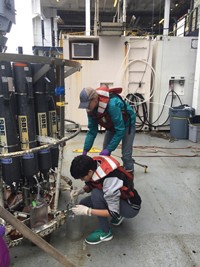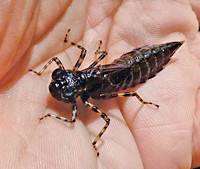Advertisement
Grab your lab coat. Let's get started
Welcome!
Welcome!
Create an account below to get 6 C&EN articles per month, receive newsletters and more - all free.
It seems this is your first time logging in online. Please enter the following information to continue.
As an ACS member you automatically get access to this site. All we need is few more details to create your reading experience.
Not you? Sign in with a different account.
Not you? Sign in with a different account.
ERROR 1
ERROR 1
ERROR 2
ERROR 2
ERROR 2
ERROR 2
ERROR 2
Password and Confirm password must match.
If you have an ACS member number, please enter it here so we can link this account to your membership. (optional)
ERROR 2
ACS values your privacy. By submitting your information, you are gaining access to C&EN and subscribing to our weekly newsletter. We use the information you provide to make your reading experience better, and we will never sell your data to third party members.
Biological Chemistry
Sniffing Out Toxic Bacteria Blooms
Water Quality: Researchers connect stinky compounds in lake scums to hazardous toxins
by Janet Pelley
September 17, 2010

In Midwestern lakes this summer, large blooms of cyanobacteria have sickened pets and people. These blooms release toxins more potent than strychnine, experts say. Now people can rely on their noses to protect themselves from the toxins, according to new research on the complex chemical mixtures in the blooms (Environ. Sci. Technol., DOI: 10.1021/es1008938).
Cyanobacteria, sometimes called blue-green algae, generate blue-green, red or brown scums on lakes. The microbes' cyanotoxins can cause skin rashes, severe stomach upset, seizures, or even death, says Jennifer Graham, a limnologist with the U.S. Geological Survey (USGS) in Kansas. People often ingest the toxins when they play or fish in lakes experiencing blooms, she says.
The World Health Organization (WHO) sets guidelines for safe recreational waters based on concentrations of microcystin, a common and easily-measured cyanotoxin. But microcystin is just one of a couple of hundred known cyanotoxins. "We wanted to know how frequently mixtures of cyanotoxins occurred," Graham says.
Graham also points out that because microcystin-testing can take up to a week, by the time regulators detect the toxin and post warnings, many people might have already been exposed. "Therefore we wondered whether a visual and odor cue could serve as a warning that cyanotoxins are present in lakes," she says.
The USGS team sampled 23 Midwestern lakes during cyanobacterial blooms. They scanned samples using liquid chromatography/tandem mass spectrometry for 13 cyanotoxins and measured two taste-and-odor compounds, geosmin and 2-methylisoborneol (MIB), which are not toxic but have a distinctive musty and earthy odor.
The scientists found microcystins in all blooms and discovered a broad mixture of toxins, including anatoxin-a, saxitoxins and cylindrospermopsins, in all but one lake. More importantly, in 91% of the blooms, the taste and odor compounds coincided with the toxins.
The study shows that the presence of odors is a good indication that multiple cyanotoxins are present, says Steve Heiskary, a research scientist with the Minnesota Pollution Control Agency.
Graham thinks that public education campaigns or posted warnings at boat launches that tell people to stay away from lakes if they see and smell blooms could be helpful. But she cautions that odor alone is not always sufficient to protect health because sometimes the toxins occur in the absence of odor.
The study is also one of the first to explicitly show that complex mixtures of toxins occur in blooms, Heiskary says. Graham points out that scientists know very little about the occurrence, seasonal patterns and health impacts of mixtures of toxins: "The findings demonstrate that we need a better understanding of complex mixtures in order to develop risk assessments."





Join the conversation
Contact the reporter
Submit a Letter to the Editor for publication
Engage with us on Twitter